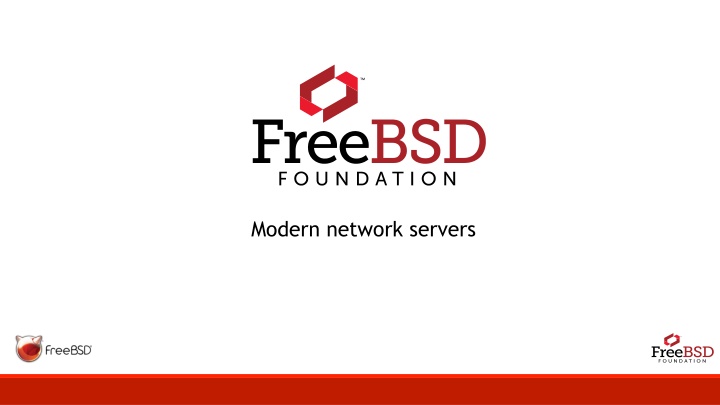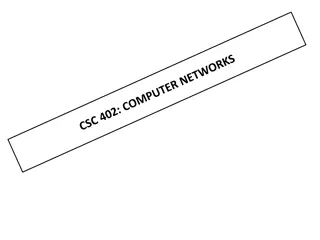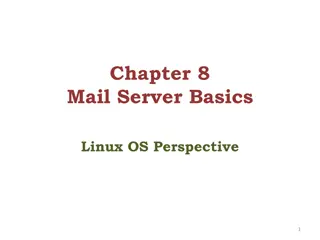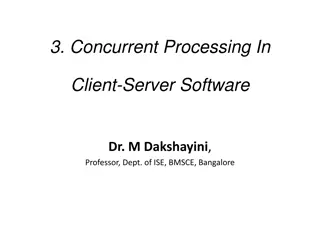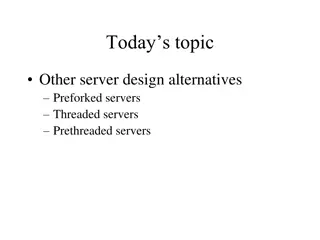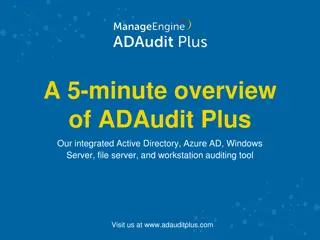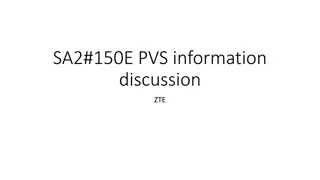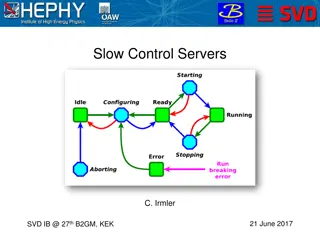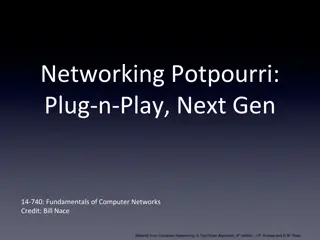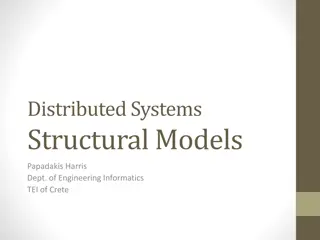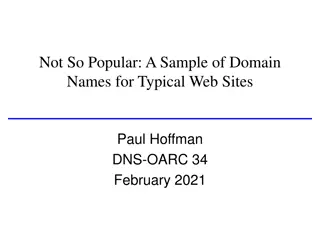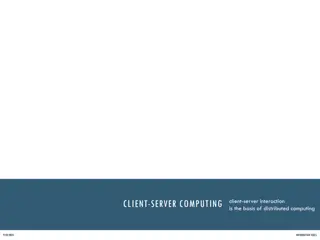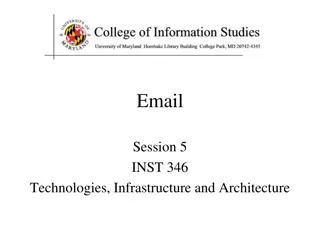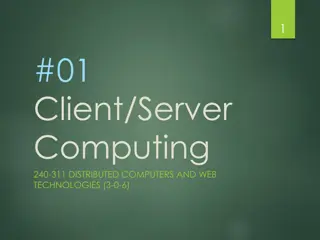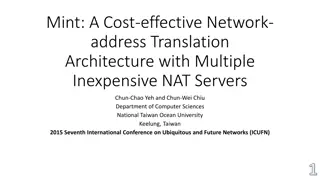Overview of Modern Network Servers
This collection presents insights into modern network servers, covering aspects such as hardware considerations, operational structures, CPU and memory resource utilization, and previous attempts at low-power, high-bandwidth CPUs. It also explores the ARM64 architecture as a new attempt at server-grade CPUs, highlighting its features and standard server peripherals. The content offers a snapshot of network server deployments, traffic data, and implementation details as of March 19th, 2018.
Download Presentation

Please find below an Image/Link to download the presentation.
The content on the website is provided AS IS for your information and personal use only. It may not be sold, licensed, or shared on other websites without obtaining consent from the author.If you encounter any issues during the download, it is possible that the publisher has removed the file from their server.
You are allowed to download the files provided on this website for personal or commercial use, subject to the condition that they are used lawfully. All files are the property of their respective owners.
The content on the website is provided AS IS for your information and personal use only. It may not be sold, licensed, or shared on other websites without obtaining consent from the author.
E N D
Presentation Transcript
Example network service: dk-hostmaster.dk SMALL COUNTRY. SMALL AMOUNT OF TRAFFIC. REPRESENTATIVE CCTLD DEPLOYMENT. 19th March 2018 MODERN NETWORK SERVERS 2
Traffic as of December 2016 Per unicast server: 1,000 qps 1.3M domain names 11,000 DNSSEC signed domains (zone size!) Total zone file size: ~190MByte raw text Depending on the nameserver: 800-1000Mbyte in RAM CPU load approximately 0 (except when loading a new zone) >10Mbps continuous traffic Data provided by dk-hostmaster.dk 19th March 2018 MODERN NETWORK SERVERS 3
Operational structure Unicast servers a.nik.dk b.nik.dk c.nik.dk l.nik.dk Implementation Off the shelf Intel servers Running FreeBSD Resource utilisation: 2 5% Anycast clouds 7 clouds >120 nodes 19th March 2018 MODERN NETWORK SERVERS 4
Network servers HARDWARE CONSIDERATIONS FOR NETWORK SERVERS VS. GENERIC-PURPOSE SERVERS 19th March 2018 MODERN NETWORK SERVERS 5
Resources network servers care about CPU: lots of trivial operations running in parallel Memory and bus bandwidth Network Disk I/O 19th March 2018 MODERN NETWORK SERVERS 6
Previous attempts at low-power, high-bandwidth CPUs Sun T1/ (SPARCv9) Cavium Octeon (MIPS) Tilera, Quanta Computer, EZChip Mellanox Intel Atom (x86) 32-bit ARM (ARMv7) 19th March 2018 MODERN NETWORK SERVERS 7
ARM64 A NEW ATTEMPT AT A SERVER-GRADE ARCHITECTURE 19th March 2018 MODERN NETWORK SERVERS 8
ARM64: a new attempt at server-grade CPUs Main architecture highlights ARMv8 a 64-bit Instruction Set Architecture AES instructions similar to Intel AES-NI (2GB/s AES in block mode on FreeBSD) Standardised on-core peripherals: GIC, MSI(-X) interrupts, timer, IOMMU Platform approach attempt at creating unified configuration mechanisms: ACPI, UEFI Standard server peripherals: AHCI for SATA, NVMe, Intel/Chelsio Ethernet 19th March 2018 MODERN NETWORK SERVERS 9
Commercial off-the-shelf hardware: Cavium Cavium ThunderX CPU 48 cores (scales to 96) 16x PCIe 3 lanes 3x 40GbE or 12x 10GbE (vnic(4)) with programmable queue processing Gigabyte server board (~$3000 USD) 1x Cavium ThunderX ARM processor 8x DDR4 DIMM slots 1x 40GbE QSFP+ LAN port and 4x 10GbE SFP+ LAN ports 4x 3.5. hot-swappable HDD/SSD bays 19th March 2018 MODERN NETWORK SERVERS 10
Commercial off-the-shelf hardware: AMD AMD A1100 CPU AMD update to the ARM Cortex A57 SoftIron (~$600 USD) AMD Opteron A1100 series processor (4 cores) 2x RDIMM with 8GB DDR4 DRAM 1x 1Gbit Ethernet 2x USB 3.0 ports 2x SATA 3.0 ports 1x 1TByte HDD 19th March 2018 MODERN NETWORK SERVERS 11
Operating system support ARM64 is a Tier-1 supported platform on FreeBSD Fully supported by binary updates (freebsd-update and pkg) Supported by security-officer and release engineering >20,000 third-party binary software packages work out of the box DNS on FreeBSD on ARM64 Full support by all common authoritative and recursive DNS implementations Binary packages available for BIND9, NSD, Knot, PowerDNS and Unbound Direct vendor support (NLNetLabs, ISC) or maintainer working closely with vendor 19th March 2018 MODERN NETWORK SERVERS 12
Performance comparison Intel Xeon E5-2630 v4 (10 cores + HT), 128GByte RAM, 2x240GByte SSD, 2x1TByte HDD Cost: ~$3,100 USD Cavium ThunderX ThunderX, 1 socket, 128GByte RAM, 4x2TByte HDD Cost: ~$3,000 USD LLVM clang build on FreeBSD-HEAD (pessimal workload) ThunderX: 32 minutes total, 74,000 minutes CPU time (20h) Xeon: 10 minutes total, 1h CPU time 19th March 2018 MODERN NETWORK SERVERS 13
DNS servers spend very little timing compiling LLVM build workload Lots of continuous disk I/O Gigantic memory footprint and churn CPU load can only be parallelised to a limited extent Authoritative DNS workload Modest amount of disk I/O when loading zone files Entire working data set fits in memory (true for most ccTLDs and nTLDs) Easy to parallelise CPU load 19th March 2018 MODERN NETWORK SERVERS 14
Power consumption and cooling Traditional x86 servers Very warm CPUs Haswell: 135W TDP (specification), ~250W under load Need lots of active cooling consumes even more power ARM64 servers Much cooler CPUs ThunderX: 120W TDP (specification), ~200W under load Several vendors sell much lower power CPUs Still need cooling but a lot less of it! 19th March 2018 MODERN NETWORK SERVERS 15
A slight digression on security Speculative execution vulnerabilities (Meltdown / Spectre) ARM64 is vulnerable to many of the same vulnerabilities as x86-64 On FreeBSD, both vulnerabilities have been mitigated in supported releases Probably not a huge concern on DNS servers 19th March 2018 MODERN NETWORK SERVERS 16
Conclusions ARM64 is a viable platform for network workloads Comparatively cheap hardware Great for parallel network-bound workloads Well-supported by FreeBSD and popular DNS software 19th March 2018 MODERN NETWORK SERVERS 17
